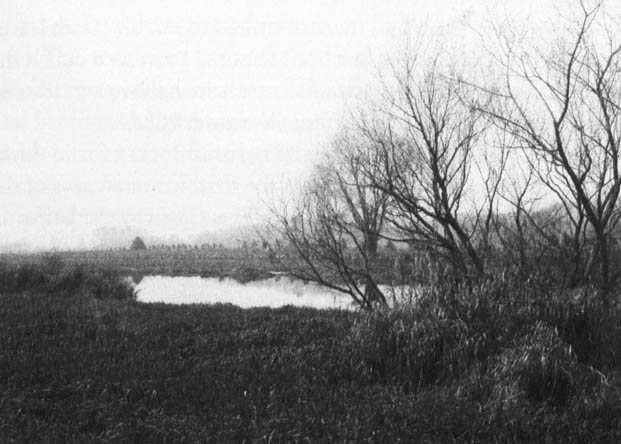
Epilogue
The River

Unidentified, undated. Great Meadows?
“In order to designate reality, Buddhism says Sunya, the void; but better still: Tathata … the fact of being this, of being thus, of being so.”
—Roland Barthes
The school of photographers known as the pictorialists would have appreciated the river Charles in autumn. On certain days there, mists and clouds roll down from the upper reaches of the watershed, softening the arches of the bridges and blurring the hard edges of the buildings of Boston, muting all color to a few monochrome shades that range from off-white to dark gray to absolute black.
The shutter snaps and the water turns to marble. Dark leaves hang on the old sycamores that line Memorial Drive, and out on the river the shells of the college students are halted, the rowers leaning forward on their oars, caught eternally in midstroke.
On November 3rd, 2001, small nervous flocks of wild ducks had settled on the wide expanses at the southwestern curve of the river, just upstream from the Eliot Bridge. Close by the banks, in Longfellow Park, white-throated sparrows were sounding out their plaintive little descending whistles, and back from the river, in the shaded islands of Mount Auburn Cemetery, I could hear the chips of savannah sparrows, the checks and clicks of passing myrtle warblers, and the hollow, popping call of the resident chipmunks. At a turning in one of the paths, a vast company of blackbirds rolled through in a chattering flock and settled on the bare branches of the oaks and the tulip trees, squawking and rasping among themselves. As I watched, for no apparent reason, they suddenly rose up in a body and spirited through the trees and shrubs, banked once, and then flowed out over the treetops to the river in a shifting dark stream.
The sometime photographer Oliver Wendell Holmes is buried at Mount Auburn Cemetery. So is the Atlantic Monthly founder, James T. Fields, as well as his associate, George Ticknor, and Henry Wadsworth Longfellow, the poet James Russell Lowell, the novelist William Dean Howells, and many of the other literary and intellectual lights of nineteenth-century America.
William Brewster is also buried here. My first frame, shot from a low angle, shows the rough landscape of his gravestone, the pink granite boulder unshaped by human hands, with wind-stripped oak branches above, a few late-clinging leaves suspended from the bare limbs like sleeping bats.
The second frame is a close-up with the name: William Brewster. Also his epitaph:
“For lo, the winter is past, the flowers appear on the earth; the time of the singing of birds is come …”
The next frame is a wide shot of the Mount Auburn Cemetery landscape, with a narrow, curving pathway winding under the skeletal beeches, the glowing white of the monumental tombs incised with twining vines, fluted pilasters and architraves, and many of the stones surmounted with ornamental urns. We see the dark islands of rhododendrons, a marble angel, half-hidden in the shrubbery, her wings spread backward, and in the distance, near a straight-trunked oak, a high marble pillar with a figure on top.
The fourth frame, taken from a rise, shows a foreground of trees and shrubs, the gray river with the silver cliff dwellings of Boston beyond, and above that a misty white nothingness, where all things are possible.
Although it too has its share of honored dead, Henry and William James, for example, the Cambridge Cemetery, which lies closer to the river, on the south side of Coolidge Avenue, is less prestigious; you will see, along with the old New England inscriptions, the names of Germans, Poles, Italians, and Swedes. Also a few Irish Protestants. And although death has equalized the races and the names are the same as those of the old English families, you will also find buried here a number of African Americans.
Inside the gates, two or three hundred yards to the south, is an unadorned tombstone with three family names inscribed on its plain marble face. Any stranger passing idly through this graveyard and happening upon this particular grave, reading the inscribed names, would not know that there are in fact four people buried beneath that stone. Three of them are listed, but the name of the fourth individual is unmarked. As with so many of the facts of the life of this invisible man, you have to search to find his identity. You’ll find him listed in the cemetery offices, in a thick record book with the inventory of burials for January, 1942:
“Robert A. Gilbert, Plot 12, Lot 4. Monbretia Path. January 13th, 1942.”
My last frame shows the Gilbert family grave. It is a squared-off, plain gravestone with a twining daisy chain running up the right and left sides and arching over to meet at the top. You see a few flecks of lichens, the unambitious sans serif lettering, and above, viewed through the lens from a low angle, a flare of branches rising upward like a fountain.
Beyond the gravestone, beyond the cemetery, a few hundred yards to the south, the dark river of grackles and redwings shifts, curves in a lazy bend, turns, and heads back for the Cambridge shore.
Below them, the Charles rolls down to the sea.